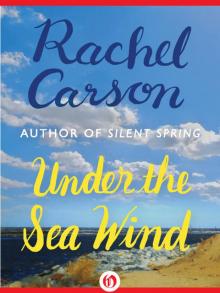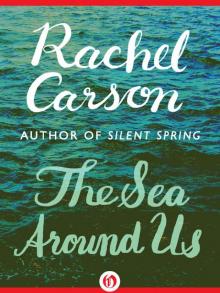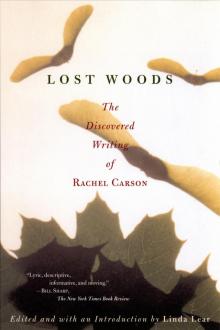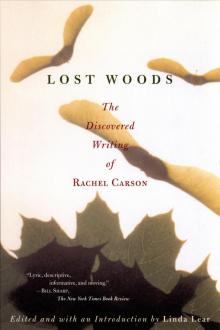- Home
- Rachel Carson
Lost Woods
Lost Woods Read online
“Linda Lear’s collection of [Rachel Carson’s] essays does a superb job of pulling from Carson’s works a collection that is lyric, descriptive, informative and moving.… This book should be required reading both for corporate managers in environmentally sensitive industries and for environmentalists and environmental scientists, who deserve the inspiration of Carson’s finely wrought, passionate prose.”
–BILL SHARP, The New York Times Book Review
“With her unique capacity to fuse scientific precision and lyrical power, Rachel Carson introduced a worldwide audience both to the principles of ecology and to their ethical, aesthetic, and spiritual implications. This collection of Carson’s writings over a span of forty-five years constitutes a stirring autobiography of the woman who became our century’s prophet of wonder.”
–JOHN ELDER, author of Reading the Mountains of Home
“Linda Lear’s selections and commentary demonstrate eloquently how Silent Spring developed as the culmination of Rachel Carson’s literary, scientific, and moral development.… For those who would know more about Rachel Carson, or about the environmental movement in the United States, Lost Woods is an enriching book.”
–JUDY KELLOGG MARKOWSKY, Habitat
“Touching all aspects of [Carson’s] work are her puzzlings over the simple fact of life and her druidic appreciation of natural cycles and the beauty, excitement, and inscrutable elements of the natural world.… [Her fans] will find in this collection an engaging glimpse into the breadth of Carson’s curiosity and the fashioning of her public voice as a defender of the environment.”
–Kirkus Reviews
“Carson’s writings have a surprising currency.… Her prescient warnings are as relevant today as they were when Carson wrote them.”
–ADELHEID FISCHER, World
“[Lost Woods] rounds out the portrait of one of the most significant people of this century.”
–Pittsburgh Magazine
“Lost Woods adds to the wealth of [Carson’s] laudable work for the planet.”
–The Earth Times
“If fleeting sketches can sometimes say more than the fully realized work, this collection of journal entries, a TV script, speeches, and articles by one of the pioneers of the modern environmental movement gracefully delivers.… The careful gathering of fragments by Lear (author of the 1997 biography Rachel Carson) … gives rare glimpses of Carson’s personal vulnerability and of her strange fusion of restraint and fervor, offering a frequent sense of being in Carson’s company.”
–Publishers Weekly
Lost Woods
The Discovered Writing of Rachel Carson
E D I T E D A N D W I T H A N I N T R O D U C T I O N B Y
L I N D A L E A R
B E A C O N P R E S S
B O S T O N
To my loving husband
John W. Nickum, Jr.
and
With gratitude to
Ruth Brinkmann Jerome
and
Ruth Jury Scott
whose lives have so richly blessed my own
Contents
Introduction
Part One
1 Undersea
2 My Favorite Recreation
3 Fight for Wildlife Pushes Ahead/ Chesapeake Eels Seek the Sargasso Sea
4 Ace of Nature’s Aviators
5 Road of the Hawks
6 An Island I Remember
7 Mattamuskeet: A National Wildlife Refuge
Part Two
8 Memo to Mrs. Eales on Under the Sea-Wind
9 Lost Worlds: The Challenge of the Islands
10 New York Herald-Tribune Book and Author Luncheon Speech
11 Jacket Notes for the RCA Victor Recording of Claude Debussy’s La Mer/National Symphony Orchestra Speech
12 Remarks at the Acceptance of the National Book Award for Nonfiction
13 Design for Nature Writing
14 Mr. Day’s Dismissal
15 Preface to the Second Edition of The Sea Around Us
Part Three
16 Our Ever-Changing Shore
17 Four Fragments from Carson’s Field Notebooks
18 The Edge of the Sea
19 The Real World Around Us
20 Biological Sciences
21 Two Letters to Dorothy and Stanley Freeman
22 The Lost Woods. A Letter to Curtis and Nellie Lee Bok
23 Clouds
Part Four
24 Vanishing Americans
25 To Understand Biology/ Preface to Animal Machines
26 A Fable for Tomorrow
27 Women’s National Press Club Speech
28 A New Chapter to Silent Spring
29 Letter to Dr. George Crile, Jr.
30 The Pollution of Our Environment
31 Letter to Dorothy Freeman
Credits
Acknowledgments
Index
Introduction
Rachel Carson’s literary legacy is only four books. But those four books are enough to have changed how humankind regards the living world and the future of life on this earth. Her literary reputation rests primarily on two of them: The Sea Around Us (1951) and Silent Spring (1962), a book that changed the course of history.
The magnitude of Carson’s impact on the public’s understanding of such issues as ecology and environmental change still astonishes. Two volumes of her trilogy on the life of the sea, The Sea Around Us and The Edge of the Sea, were serialized in the New Yorker, and all three, including Under the Sea-Wind (1941), appeared on the New York Times best-seller list for months on end. The Sea Around Us maintained its place for a record eighty-six weeks and was eventually translated into more than forty languages. Silent Spring was also serialized in the New Yorker, making Carson the first woman writer to have three of her works introduced in its pages by 1962. It was translated into many languages, and still sells over 25,000 copies every year. Rachel Carson had garnered an international reputation as a natural scientist and public voice for the care of the earth by the time of her death in 1964. She was the most acclaimed science writer of her generation and a literary figure of first rank.
The purpose of Lost Woods, this collection of Carson’s undiscovered and little known writing, is to give the reader what is missing from the more famous body of Carson’s work – a sense of her evolution as a natural scientist and a creative writer. Carson’s unpublished and heretofore unknown literary output only heightens her importance as an environmental thinker. In this anthology, Carson’s public and private voice speaks to our human condition and to the condition of our earth at the end of the millennium. Encompassing youthful writing, newspaper essays, field journals, speeches, articles, and letters, Lost Woods intimately reveals the intellectual process by which Carson became not just a literary celebrity, but one of the century’s most important writers and social commentators, whose call to alarm took us all in a new direction and was the catalyst for the contemporary environmental movement.
The pace and pressure of Rachel Carson’s life mitigated against there ever being a large body of writing. By nature she worked slowly and methodically, unwilling to move from one sentence to another until the first met her syntactical and lyrical satisfaction. She revised endlessly, read everything out loud, and then had it read back to her until she was satisfied with its tone, alliteration, and clarity. A perfectionist in form and structure, Carson was also a meticulous researcher whose demand for accuracy was legendary among her government colleagues, assistants, and editors.
It was gratifying for me to learn that Carson never finished a manuscript or an article on time with the exception of the feature stories she wrote for the Baltimore Sun in the 1930s. But it was heartrending to piece together the nearly overwhelming burden of family responsib
ility and emotional demand that prevented her from achieving the corpus of work that she dreamed of producing, and had the talent and vision to create.
Beginning in the late 1930s, Carson supported herself, her mother, her sister, and later her sister’s two daughters, and her grand-nephew whom she adopted in 1957. A fifteen-year career in the federal government as an aquatic biologist and editor relegated her writing to evenings and time snatched between weekend obligations, yet also deepened her experience of the living world and her commitment to preserving it.
The literary success of The Sea Around Us brought a measure of financial security and enabled Carson to devote all her time to her writing after 1952. She enjoyed only a few years of freedom before her mother’s physical decline, her niece’s death, and the needs of a young child again stole her creative time and taxed her emotional stamina. The last five years of Carson’s life were a race against time and the course of terminal illness. Fighting a misdiagnosed and aggressive breast cancer, Carson endured the side effects of treatment and the ravages of what she called a “catalogue of illnesses” to complete Silent Spring and to defend it. What is remarkable is not that Carson produced such a small body of work, but that she was able to produce it at all.
Rachel Carson had plans for at least four other major works. She had been collecting material for a scientific study of evolution, and had a book contract for another, more philosophical examination of ecology. She had started to revise and expand an earlier magazine article on exploring the natural world with children, and she was intrigued by the new discoveries in atmospheric science and climate and hoped to write something in this emerging field. Carson’s literary papers display a full range of topics that she had, in one way or another, committed herself to writing about, and many more that she hoped one day to have the time to pursue. But time ran out in April 1964.
Lost Woods helps us fill the gap between Carson’s wishes and her accomplishments. Selections from her field notebooks and especially her public speeches give Rachel Carson a voice for generations who neither heard her speak nor saw her on the few television appearances she made. Although she never thought of herself as a public figure, she became one, and was an accomplished public speaker as well, whose integrity captured the attention of the politically powerful and the average citizen alike. Her articles on the natural history of the Chesapeake region, her political acumen displayed in several editorial page letters, and her support of a wide variety of conservation and preservation efforts provide new facets to the better known lyrical writer on the sea, and trenchant critic of toxic chemicals.
The writings selected for Lost Woods are, for the most part, those I discovered in the course of my research for Rachel Carson: Witness for Nature, in her papers at the Beinecke Rare Book and Manuscript Library at Yale University. They have been chosen for their literary quality, as examples of important environmental thinking, and for the creative insight they provide into Carson’s evolution as a scientist and science writer.
Several provide evidence of subjects about which Carson had an intense interest but never had opportunity to write about in any great depth. Other selections, including an article that appeared in Holiday, the preface to the second edition of The Sea Around Us, and the “Fable for Tomorrow” from Silent Spring, were published during Carson’s lifetime and merit special attention. Some were published posthumously and are included here because of their scientific and literary quality and their biographical importance. A few others were published in journals, in newspapers, or as government documents and are no longer in print.
Carson once told her friend Dorothy Freeman that she considered her contributions to scientific fact less important than her attempts to awaken an emotional response to the world of nature. Describing the intent of her writing in a 1956 article on exploring nature with children, Carson wrote, “Once the emotions have been aroused – a sense of the beautiful, the excitement of the new and the unknown, a feeling of sympathy, pity, admiration or love – then we wish for knowledge about the object of our emotional response. Once found, it has lasting meaning.”
The woman, the scientist, the reformer, and especially the writer who emerges from this collection elegantly combined science and emotion, reason and humanity. Lost Woods gives Rachel Carson a new and more complete voice for nature.
Here one will find further evidence of the centrality of ecological relationships in Carson’s thought, and of her understanding of environmental ontology – the wholeness of nature. Displayed here as well is Carson’s deep anxiety over the future of nuclear technology and how it might alter the intricate fabric of life.
But these selections also show for the first time that Carson’s well-known support of wilderness preservation and wildlife conservation was particularly directed to the preservation of the nation’s remaining wild seashores – areas that were fast disappearing in her own time.
Two selections testify to Carson’s deep interest in animal rights. These issues were a natural extension of her lifelong reverence for life. Had she lived longer, she certainly would have become more politically active and would have written in support of humane treatment of laboratory and farm animals.
Carson had only begun to explore the evidence of global climate change before she died. Research for her 1957 television script on clouds revitalized her early interest in atmospheric temperature and wind which she had studied and written about in The Sea Around Us. She wanted to pursue this subject, and was convinced even then of the important relationship between human activity and alterations in climate.
Carson has much to teach deep ecologists and environmental policy makers as they wrestle with the moral dilemma of whether or not to moderate their demands and conform to political reality. Many will find insight in Carson’s editorial writing and in her speeches on how to create conditions conducive to environmental reform. Carson’s understanding of political process and the need for flexibility and compromise, as well as for intellectual toughness, can only encourage those who, like her, are searching for ways to move a democratic system off dead center.
Finally I have chosen to include several intimate pieces of writing. Carson’s field notebooks are filled with incisive biological and ecological observation, but they also contain lyric vignettes that capture moments of dazzling humility. Similarly in letters to her friends and Maine neighbors Dorothy and Stanley Freeman, to Curtis and Nellie Lee Bok, and to her physician, George Crile, Jr., Carson reveals her deep love for the living world, and in the process, her quiet courage.
Not only does Lost Woods contain the discovered writing of one of the great writers and thinkers of our time, but it also illuminates a whole new Rachel Carson. Her outwardly calm and placid public life disguised the private passion as well as the complexity of her love for the natural world and her commitment to its wholeness. It is my hope that in this new collection of Rachel Carson’s writing, readers may find and appreciate her varied and timeless voice.
Part One
The writings in Part One reflect the diversity of Carson’s early interests and her efforts to find subject and style for her writing. It opens with the essay “Undersea,” a characteristically searching and lyrical piece, which inaugurated her public literary career when it was published in the Atlantic Monthly in 1937. Part One ends with selections from “Mattamuskeet,” one of five Conservation in Action pamphlets Carson wrote and edited for the U.S. Fish and Wildlife Service. She was the second female professional hired by the agency, and during her fifteen-year federal career there, rose from aquatic biologist to editor-in-chief of all Service publications.
“Mattamuskeet” reflects the confident writing of a mature scientist who knows her subject, her audience, and her public mission to inform. It also exhibits Carson’s understanding of the intricate ecology of a wildlife habitat and her desire to communicate the importance of these ecological relationships.
Between these two selections is a telling example of childhood writing and several journ
alistic features written for the Baltimore Sun that demonstrate Carson’s lifelong interest in the preservation of wildlife, her skeptical view of human interference in the natural world, and her passionate interest in birds. Two unpublished literary fragments from the 1940s testify to Carson’s growing sophistication as a naturalist and nature writer. Taken together, these writings offer a window to Rachel Carson’s early ecological consciousness and her evolution as a natural scientist.
1
[1937]
Undersea
“UNDERSEA” was originally titled “The World of Waters” and written as an introduction to a U.S. Bureau of Fisheries brochure in 1935. Carson’s supervisor correctly assessed it as too lyric for a government report and encouraged her to submit it to the Atlantic Monthly, where it was published by editor Edward Weeks. “Undersea” subsequently became the basis of Carson’s first book, Under the Sea-Wind (1941), which remained her favorite piece of writing.
The title “Undersea” was suggested by the Atlantic’s editor who was impressed with Carson’s illumination of science “in such a way as to fire the imagination of the layman.” Its publication marked Carson’s literary debut as a writer of critical merit.
Here Carson surveys both the ordinary and fantastic creatures of the sea from the immediate perspective of an underwater eye, making the mystery and beauty of that world accessible to the non-scientific reader. “Undersea” introduces two of Carson’s signature themes: the ancient and enduring ecology that dominates ocean life, and the material immortality that encompasses even the smallest organism. From these four remarkable pages in the Atlantic, Carson later admitted, “everything else followed.”
WHO HAS KNOWN THE OCEAN? Neither you nor I, with our earth-bound senses, know the foam and surge of the tide that beats over the crab hiding under the seaweed of his tide-pool home; or the lilt of the long, slow swells of mid-ocean, where shoals of wandering fish prey and are preyed upon, and the dolphin breaks the waves to breathe the upper atmosphere. Nor can we know the vicissitudes of life on the ocean floor, where the sunlight, filtering through a hundred feet of water, makes but a fleeting, bluish twilight, in which dwell sponge and mollusk and starfish and coral, where swarms of diminutive fish twinkle through the dusk like a silver rain of meteors, and eels lie in wait among the rocks. Even less is it given to man to descend those six incomprehensible miles into the recesses of the abyss, where reign utter silence and unvarying cold and eternal night.

 Silent Spring
Silent Spring Under the Sea Wind
Under the Sea Wind The Edge of the Sea
The Edge of the Sea The Sea Around Us
The Sea Around Us Lost Woods: The Discovered Writing of Rachel Carson
Lost Woods: The Discovered Writing of Rachel Carson Lost Woods
Lost Woods